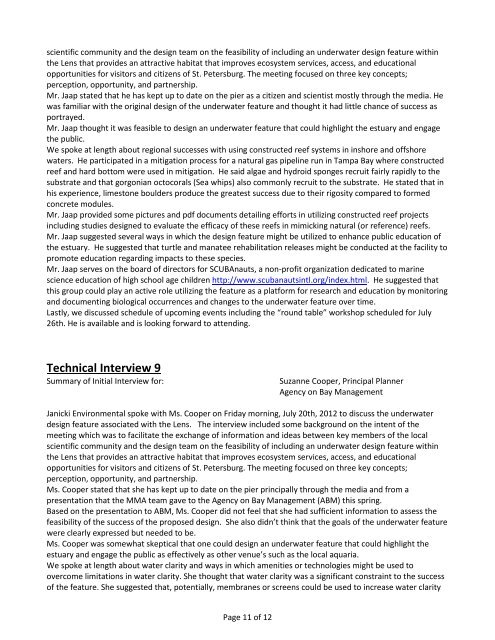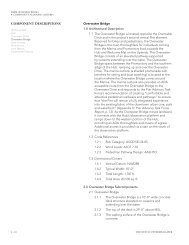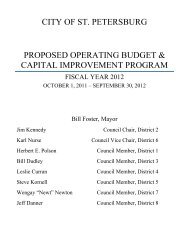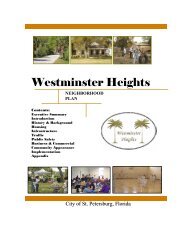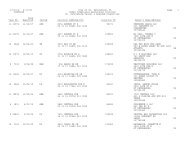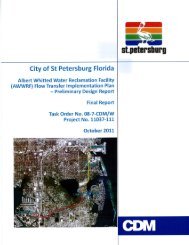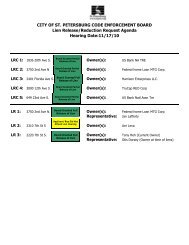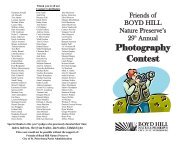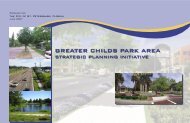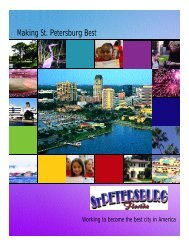Basis of Design Book 2 - City of St. Petersburg
Basis of Design Book 2 - City of St. Petersburg
Basis of Design Book 2 - City of St. Petersburg
Create successful ePaper yourself
Turn your PDF publications into a flip-book with our unique Google optimized e-Paper software.
scientific community and the design team on the feasibility <strong>of</strong> including an underwater design feature within<br />
the Lens that provides an attractive habitat that improves ecosystem services, access, and educational<br />
opportunities for visitors and citizens <strong>of</strong> <strong>St</strong>. <strong>Petersburg</strong>. The meeting focused on three key concepts;<br />
perception, opportunity, and partnership.<br />
Mr. Jaap stated that he has kept up to date on the pier as a citizen and scientist mostly through the media. He<br />
was familiar with the original design <strong>of</strong> the underwater feature and thought it had little chance <strong>of</strong> success as<br />
portrayed.<br />
Mr. Jaap thought it was feasible to design an underwater feature that could highlight the estuary and engage<br />
the public.<br />
We spoke at length about regional successes with using constructed reef systems in inshore and <strong>of</strong>fshore<br />
waters. He participated in a mitigation process for a natural gas pipeline run in Tampa Bay where constructed<br />
reef and hard bottom were used in mitigation. He said algae and hydroid sponges recruit fairly rapidly to the<br />
substrate and that gorgonian octocorals (Sea whips) also commonly recruit to the substrate. He stated that in<br />
his experience, limestone boulders produce the greatest success due to their rigosity compared to formed<br />
concrete modules.<br />
Mr. Jaap provided some pictures and pdf documents detailing efforts in utilizing constructed reef projects<br />
including studies designed to evaluate the efficacy <strong>of</strong> these reefs in mimicking natural (or reference) reefs.<br />
Mr. Jaap suggested several ways in which the design feature might be utilized to enhance public education <strong>of</strong><br />
the estuary. He suggested that turtle and manatee rehabilitation releases might be conducted at the facility to<br />
promote education regarding impacts to these species.<br />
Mr. Jaap serves on the board <strong>of</strong> directors for SCUBAnauts, a non-pr<strong>of</strong>it organization dedicated to marine<br />
science education <strong>of</strong> high school age children http://www.scubanautsintl.org/index.html. He suggested that<br />
this group could play an active role utilizing the feature as a platform for research and education by monitoring<br />
and documenting biological occurrences and changes to the underwater feature over time.<br />
Lastly, we discussed schedule <strong>of</strong> upcoming events including the “round table” workshop scheduled for July<br />
26th. He is available and is looking forward to attending.<br />
Technical Interview 9<br />
Summary <strong>of</strong> Initial Interview for:<br />
Suzanne Cooper, Principal Planner<br />
Agency on Bay Management<br />
Janicki Environmental spoke with Ms. Cooper on Friday morning, July 20th, 2012 to discuss the underwater<br />
design feature associated with the Lens. The interview included some background on the intent <strong>of</strong> the<br />
meeting which was to facilitate the exchange <strong>of</strong> information and ideas between key members <strong>of</strong> the local<br />
scientific community and the design team on the feasibility <strong>of</strong> including an underwater design feature within<br />
the Lens that provides an attractive habitat that improves ecosystem services, access, and educational<br />
opportunities for visitors and citizens <strong>of</strong> <strong>St</strong>. <strong>Petersburg</strong>. The meeting focused on three key concepts;<br />
perception, opportunity, and partnership.<br />
Ms. Cooper stated that she has kept up to date on the pier principally through the media and from a<br />
presentation that the MMA team gave to the Agency on Bay Management (ABM) this spring.<br />
Based on the presentation to ABM, Ms. Cooper did not feel that she had sufficient information to assess the<br />
feasibility <strong>of</strong> the success <strong>of</strong> the proposed design. She also didn’t think that the goals <strong>of</strong> the underwater feature<br />
were clearly expressed but needed to be.<br />
Ms. Cooper was somewhat skeptical that one could design an underwater feature that could highlight the<br />
estuary and engage the public as effectively as other venue’s such as the local aquaria.<br />
We spoke at length about water clarity and ways in which amenities or technologies might be used to<br />
overcome limitations in water clarity. She thought that water clarity was a significant constraint to the success<br />
<strong>of</strong> the feature. She suggested that, potentially, membranes or screens could be used to increase water clarity<br />
Page 11 <strong>of</strong> 12


